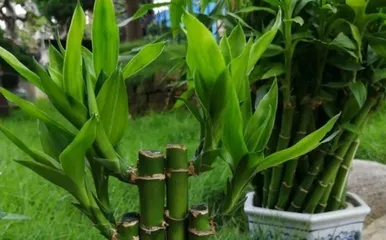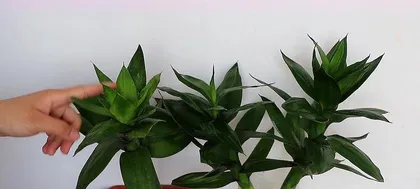Lucky bamboo, also known as lucky bamboo or auspicious bamboo, is beloved for its green leaves and sturdy, golden-like bamboo joints, symbolizing good fortune, wealth, and longevity. Typically, people grow lucky bamboo in water, but did you know it can also be grown in soil? So, how exactly do you grow lucky bamboo in soil? Let's explore this together.

I. Prepare Suitable Soil
To ensure the healthy growth of lucky bamboo, suitable soil is required. The soil should be a well-draining and moisture-retentive substrate. You can purchase soil suitable for growing lucky bamboo at gardening centers or flower shops.
II. Choose the Right Pot
Planting lucky bamboo in a suitable pot is crucial for its growth. The pot should not only be aesthetically pleasing but also have good air permeability and drainage. It is generally recommended to use pots made of materials like red clay, ceramic, or glass jars.

III. Choose the Right Variety of Lucky Bamboo
There are many varieties of lucky bamboo on the market. Some are suitable for water cultivation, while others are better for soil. When selecting lucky bamboo, it's important to choose a variety suitable for your chosen cultivation method. Varieties that are well-suited for soil cultivation include Iron Bamboo, Nest Bamboo, and Black Gold Bamboo.
IV. Pay Attention to Watering
When growing lucky bamboo in soil, it's important to manage watering. The amount should be moderate—neither too much nor too little. Generally, watering once a week is sufficient.
V. Pay Attention to Fertilizing
Proper fertilization is very important when growing lucky bamboo in soil. To promote growth, fertilize the plant once a month. You can use a fertilizer specifically designed for plants.

VI. Prune Lucky Bamboo Appropriately
Growing lucky bamboo in soil requires occasional pruning. Pruning helps maintain lush foliage and makes the plant more attractive. However, it's essential to prune at the right time and in the correct manner.
VII. Make Full Use of Sunlight
Sunlight is essential for the growth of lucky bamboo. Adequate sunlight will make the leaves broader, fuller, and more ornamental. When placing lucky bamboo indoors, choose a bright, well-ventilated spot.
VIII. Pay Attention to Temperature
Temperature is a key factor when growing lucky bamboo in soil. The ideal temperature range for growth is between 15°C and 30°C. Temperatures that are too high or too low can negatively affect its growth. Keep the indoor temperature within this suitable range.
IX. Control Air Humidity
Indoors, air humidity is very important for lucky bamboo's health. To ensure proper growth, control the indoor humidity. You can adjust humidity by misting the plant or using a humidifier.
X. Pay Attention to Pest and Disease Control
When growing lucky bamboo in soil, be mindful of pests and diseases. Common problems include aphids, spider mites, and whiteflies. To keep the plant healthy, detect and treat these issues promptly.
XI. Replace the Soil Regularly
To ensure the continued health of your lucky bamboo, the soil should be replaced periodically. Generally, changing the soil once a year is enough.
XII. Place Lucky Bamboo Appropriately
Proper placement is also very important. Choose a location that is well-ventilated, gets plenty of light, and has a suitable temperature for your lucky bamboo.
XIII. Pay Attention to Transplanting
If you need to transplant your lucky bamboo, pay attention to the timing and method. It's best to transplant in the spring, and be careful to keep the root system intact.
XIV. Deal With Withered Leaves Promptly
As your lucky bamboo grows, some leaves may naturally wither. Removing these promptly helps the plant grow better.
XV.
There are many key points to consider when growing lucky bamboo in soil, including soil type, pot selection, watering, fertilizing, pruning, sunlight, temperature, and humidity. Only by mastering these care techniques can you ensure your lucky bamboo thrives, bringing you good luck and a pleasant mood.